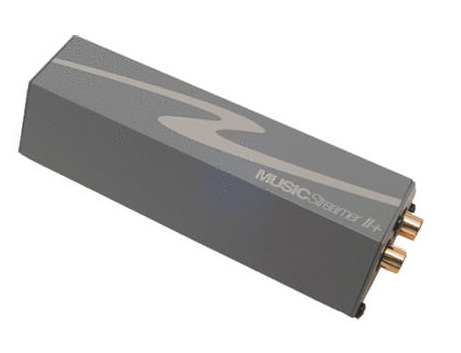|
You are reading the older HTML site
Positive Feedback ISSUE 51
The Neoteric Listener...
and the HRT Music Streamer II+ and a Tube Upgrade to Virtue
Audio Sensation M901 Integrated Amplifier
In the early 80s, I yearned for the computer savvy to commandeer my pal's Apple IIe and slalom that bad boy with all the blistering fury its 1.023 mHz processor could handle. Fired up, I enrolled in a computer programming class, but I couldn't navigate the curve of writing enough BASIC code to produce a measly picture of a Christmas tree for the midterm. Two months and one C- later, I figured that it was a hell of a lot of work just to be able to play The Bilestoad and mutilate very slow moving cyber enemies. So I watched my friends rescue the Princess of Persia and battle space pirates, while I settled for not crashing the computer and losing last minute "don't touch the ink, professor" term papers. Today, as I read Dave Clark's ongoing series of Ramblings and Andy Schaub's Building a Digital Musical Server articles, I sometimes feel like I'm still trapped in the Christmas tree code. I refuse to be on the sidelines, though, so I reread, regurgitate, and rethink until it's relatively straight in my mind. Understand, I have no intention to muck the digital swamp like Dave and Andy until I'm a lot richer and smarter (pretty unlikely on both counts), but as with many of us, the computer is fast becoming the music source most often used. I like being able to stream radio from all over the world, and I especially like being able to retrieve my music library without having to the little world of my armchair. Oh, I still prefer vinyl and tape (ironic, considering I'm currently bereft of both turntable and reel to reel), but digital offers an ease of convenience, discovery, and sound quality that has vastly improved my musical enjoyment. But good luck trying to explain all this to somebody who's not into audio, much less get him or her excited about it, which is why I love products like the HRT Music Streamer II+ DAC. The quicker the route from open box to play music, the easier it is to convince most people that audio is a place they want to be, and the Streamer II+ is nothing if not simple to use. Insert the Furutech USB port of my Macbook Pro (applications such as iTunes or Windows Media Player are fully supported), plug in the Stereolab RCA cables into the Virtue Audio Sensation amp on review, and let the songs of glory commence. Granted, you'll need to download something like Amarra or Pure Vinyl to play your high rez-files, but that process turned out to be pretty painless and well worth the time.
Which is all to say, the HRT Music Streamer II+ is one of those products that fills a need exactly at the right time, in that it offers a simple solution for the non-audiophile crowd who would like to be a part of computer audio without having to spend big money, clear cluttered shelves, or read turgid manuals. The Streamer II+ utilizes an asynchronous protocol which is claimed to reduce jitter, and has an interface data rate up to 96k and bit depth up to 24 bit, which opens up the world of high resolution audio files at a reasonable cost (the playback, not the recordings themselves!). Readers of this column know that my I prize the devilsound 2.1 DAC for being similarly no-hassle, and I've always enjoyed its sound. And while I don't like to compare products directly because it's usually a case of things sounding different (as opposed to better, if you understand) it was nice to have the devilsound on hand to provide an easy reference point for discussion. While some people may have the audio memory of a freshly taunted teenager, with things like a DAC, it really helps me to be able to evaluate in real time. The devilsound is smaller, and lacks the heft and weight of the HRT model, but both of them can easily be concealed or displayed, depending on the needs of the decor. In direct comparison between the two, playing standard Red Book CDs sampled at 44.1kHz and using Apple Lossless, I felt that the devilsound was more resolving and created a slightly more pronounced soundstage. On some files, this attribute was well received, but on a few rare files featuring very bright instruments or on poor recordings, things frayed to the point of harshness. I should add that I only notice this trait when I directly following the HRT. The Music Streamer II+, in contrast, delivered a more substantial, fuller presentation of the music, but some files sounded slightly muddied when compared to the devilsound. Switching out USB and RCA cables on the HRT somewhat altered the degree of this sonic difference, but overall the comparison held. Both units did a fantastic job playing music and I could recommend either to budding audiophiles on a budget looking for a simple to use DAC. The Streamer II+, however, is a bargain because at $349 it's fifty dollars cheaper than its competition; however, you'll need to supply your own USB and RCA cables, unlike the devilsound. But the main thing that separates this HRT DAC from others of its ilk is that it capably handles 24 bit/96 kHz files. For many people, this fact will be the deciding factor in purchasing it over other products. My music preferences make my shopping trip at the high rez store a pretty quick affair, but the recent HDTracks release of Jerry Lee Lewis and Johnny Cash came at an opportune time to test the HRT's playback capabilities. The chance to hear the man in black sing the line "I shot a man in Texas, just to watch him die" in full dimension gravel is almost worth the price of the HRT all by itself. Similarly, on the cut "Big Shoe" from the album Side by Side, Johnny Hodges plays runs on his alto sax that later rock guitarists would "pay homage" to for years. Sax and trombone (played expertly on this track by Lawrence Brown) are tough instruments to record and play back, but both sound magnificent on this file, as delivered by the HRT. Billy Holliday's voice, too, on "Strange Fruit" is rendered with all the texture necessary to accurately express this scathing indictment of lynching in the deep south. Not to say that I wouldn't prefer to hear it on a good vinyl playback system, but in this instance, the Streamer II+ produces powerful and emotive music good enough to make you be almost completely unaware of its digital source. All in all, the HRT Music Streamer II+ offers a fine means for the emerging audiophile to make a smooth entrance into the world of high resolution, without having to take a community college course in computers or worry about the next upgrade in digital playback. Recommended.
HRT Music Streamer II+ DAC http://www.highresolutiontechnologies.com
Sensation M901 Update Those of you who happened to read my review of the Virtue Audio Sensation M901 integrated amplifier know that I appreciated its ability to produce a highly engaging and detailed sound from my Nola Boxers and Tannoy Eyris I standmounts. In fact, my only reservation about the M901 was a slight hardening of the strings during Leonard Britton's "Sinfonia de requiem Dies ira." Now, this doesn't bother me much, as I only occasionally play orchestral works, but I thought that I should point it out for those who do. Fortunately, I also knew that the M901 could be upgraded with a Dodd no-gain tube-buffer, which, according to Virtue Audio, "adds additional resolution and the softness of tubes." I've been fortunate to audition this amplifier upgrade for more than a month now, and there's no doubt that the tube buffer reduces the edge of what was already a very clean sounding amplifier. The stock JJ 12 AX7 tube gives a subtle roundness to tones that is really pleasing, without eroding the clarity that makes the Sensation such a remarkable product. If you're the skeptical type when it comes to this sort of thing (and who isn't?), the Dodd tube buffer upgrade comes with a "judge it for yourself" switch inside the chassis. Take an allen wrench, remove the screws and pull off the top panel, and move the switch to engage or disengage the tube buffer. Personally, I couldn't imagine a time when I wouldn't want the tube on, but it's nice to have the opportunity to see if the extra cash was justified. By the way, tube rolling is encouraged, and the Virtue Audio community on AudioCircle is more than happy to share experiences and expertise on the preferred tube for the job. One member, Ozark Tom, was even kind enough to send me an RCA 5751 to audition, and substituting this tube imparted a perceptible warmth and musicality to the sound. Is the tube buffer worth the extra $300? Well, it would have been! I say "would have" because, in the time between the previous review and this update, Virtue Audio has sold out of every last Sensation M901. It seems Seth Krinsky, the man behind Virtue Audio, needed to shore up his finances so that he would be in a position to propose to his then girlfriend. To do this, he held a once-in-a-lifetime sale "Melissa Sale" offering 20% off all Sensations sold so that he could then propose to his beloved, named, yep, Melissa. The amp sold out, the girl said yes, and nuptials are in the offing. As an aside, the Melissa Sale and Ozark Tom are two things that make the audio industry so interesting and enjoyable. The small companies run by a handful of people who make amazing, innovative products provide the dynamic energy that makes the hobby more than just an exercise in consumerism. Large corporations have their merits, too, but it's heartening to know that manufacturers like Seth Krinsky communicate with customers such as Ozark Tom about how to enjoy music, and music products, to the fullest extent possible. Jazzes me up, anyway. If you missed out on the Melissa sale, don't despair, for new ones are scheduled to be produced later this year. For those of you who simply must hear this company's products in your home right this moment, then here's a suggestion. The Virtue Audio M451 can be upgraded with copper posts, sonicaps, the Dodd buffer, and a 5 Ah continuous charge battery pack, and the manufacturer claims it sounds even better than the Sensation M901. I can't verify that, but I do know that Virtue Audio products have more than exceeded all my expectations in the past, so I wouldn't doubt the claim. And, if you're interested in buying, I wouldn't wait around to pull the trigger, either. Weddings, honeymoons, and clamoring Virtue Audio fans won't wait.
The Virtue Audio Sensation M901
|



